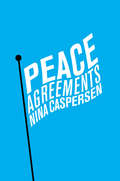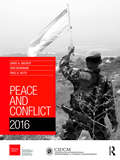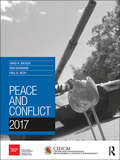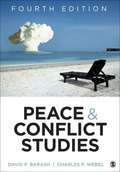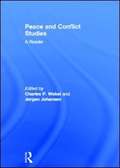- Table View
- List View
Peace Agreements: Finding Solutions to Intra-state Conflicts
by Nina CaspersenSince the end of the Cold War a significant number of peace agreements have been signed, many of them in bloody intra-state conflicts that were previously thought beyond resolution. How have these agreements addressed issues of territory, security, power and justice? Do they reveal a blueprint for peace, and what can we learn from both their successes and their failures? This timely book provides a comprehensive and cutting-edge analysis of peace agreements signed in separatist conflicts from 1990 to the present day. Drawing on a diverse range of cases, including Bosnia, Indonesia, the Philippines, Sudan, Israel-Palestine and Ukraine, it analyses the different peace 'packages', focusing on the interaction of the elements in play, and exploring the impact of political contestation within conflict parties and of peace process dynamics. Though some of these agreements have displayed great ingenuity in finding lasting solutions, many have relied on more traditional, and often problematic, designs. For all such agreements, the enduring challenge is that of ensuring flexibility while avoiding destructive ambiguity. This is why the content of peace agreements really matters - not only to sustain peace once it is achieved but to make the prospect of peace possible in the first place.
Peace and Conflict 2008
by J. Joseph Hewitt Jonathan Wilkenfeld Ted Robert GurrPeace and Conflict is a biennial publication that provides key data and documents trends in national and international conflicts ranging from isolated acts of terrorism to internal civil strife to full-fledged interstate war. Peace and Conflict is a large format, full-color reference including numerous graphs, tables, maps, and appendices dedicated to the visual presentation of data. Crisp narratives are highlighted with pull-quote extracts that summarize trends and major findings.
Peace and Conflict 2008
by J. Joseph Hewitt Jonathan Wilkenfeld Ted Robert GurrPeace and Conflict is a biennial publication that provides key data and documents trends in national and international conflicts ranging from isolated acts of terrorism to internal civil strife to full-fledged interstate war. Peace and Conflict is a large format, full-color reference including numerous graphs, tables, maps, and appendices dedicated to the visual presentation of data. Crisp narratives are highlighted with pull-quote extracts that summarize trends and major findings.
Peace and Conflict 2010
by J. Joseph HewittPeace and Conflict is a new biennial publication that provides key data and documents trends in national and international conflicts ranging from isolated acts of terrorism to internal civil strife to full-fledged intercountry war. A major trend it tracks is the incidence of wars beyond the protracted conflicts in Iraq and Afghanistan. For 2010, Peace & Conflict adds a new regular feature-Trends in Global Terrorism-and focuses on the theme of Challenges of Post-Conflict Transitions. It covers special topics including women and post-conflict settings, and truth commissions and tribunals. Peace and Conflict is a large format, full-color reference including numerous graphs, tables, maps, and appendices dedicated to the visual presentation of data. Crisp narratives are highlighted with pull-quote extracts that summarize trends and major findings such as the continuing increase in high casualty terrorist acts and the likelihood of genocide risk in certain areas.
Peace and Conflict 2010 (Peace And Conflict Ser.)
by J.Joseph HewittPeace and Conflict is a new biennial publication that provides key data and documents trends in national and international conflicts ranging from isolated acts of terrorism to internal civil strife to full-fledged intercountry war. A major trend it tracks is the incidence of wars beyond the protracted conflicts in Iraq and Afghanistan. For 2010, Peace & Conflict adds a new regular feature-Trends in Global Terrorism-and focuses on the theme of Challenges of Post-Conflict Transitions. It covers special topics including women and post-conflict settings, and truth commissions and tribunals. Peace and Conflict is a large format, full-color reference including numerous graphs, tables, maps, and appendices dedicated to the visual presentation of data. Crisp narratives are highlighted with pull-quote extracts that summarize trends and major findings such as the continuing increase in high casualty terrorist acts and the likelihood of genocide risk in certain areas.
Peace and Conflict 2012
by J.Joseph HewittPeace and Conflict is a biennial publication that provides key data and follows trends in national and international conflicts ranging from isolated acts of terrorism to internal civil strife to full-fledged inter-country war. A major trend it tracks is the incidence of wars beyond the protracted conflicts in Iraq and Afghanistan. Peace and Conflict 2012 focuses on the theme of policy guidance for preventing conflict. It covers special topics with original contributions that focus on mediation, economic recovery, and the impact of elections. Peace and Conflict is a large-format reference book including numerous graphs, tables, maps, and appendices dedicated to the visual presentation of data. Crisp narratives are highlighted with box quote extracts that summarise trends and major findings such as the continuing increase in high casualty terrorist acts and risk of genocide in certain areas.
Peace and Conflict 2012 (Peace And Conflict Ser.)
by J.Joseph HewittPeace and Conflict is a biennial publication that provides key data and follows trends in national and international conflicts ranging from isolated acts of terrorism to internal civil strife to full-fledged inter-country war. A major trend it tracks is the incidence of wars beyond the protracted conflicts in Iraq and Afghanistan. Peace and Conflict 2012 focuses on the theme of policy guidance for preventing conflict. It covers special topics with original contributions that focus on mediation, economic recovery, and the impact of elections. Peace and Conflict is a large-format reference book including numerous graphs, tables, maps, and appendices dedicated to the visual presentation of data. Crisp narratives are highlighted with box quote extracts that summarise trends and major findings such as the continuing increase in high casualty terrorist acts and risk of genocide in certain areas.
Peace and Conflict 2014 (Peace and Conflict)
by Paul K. Huth Jonathan Wilkenfeld David A. BackerPeace and Conflict is a biennial publication that provides cutting-edge data and analysis concerning domestic and international conflicts and corresponding peacebuilding activities. The book include forecasts of risks of political and social instability, as well as trends and patterns in conflict. The 2014 edition focusses on the 'micro level' in the study of conflict and peacebuilding, such as social relationships below the level of the nation-state, with attention to key topics such as ethnicity, climate change, foreign aid and sexual violence. Peace and Conflict is a large-format, full-color resource with numerous graphs, tables, maps, and appendices dedicated to the visual and summary presentation of information. Crisp narratives are highlighted with pull-quote extracts emphasizing major findings.
Peace and Conflict 2014 (Peace and Conflict)
by Paul K. Huth Jonathan Wilkenfeld David A. BackerPeace and Conflict is a biennial publication that provides cutting-edge data and analysis concerning domestic and international conflicts and corresponding peacebuilding activities. The book include forecasts of risks of political and social instability, as well as trends and patterns in conflict. The 2014 edition focusses on the 'micro level' in the study of conflict and peacebuilding, such as social relationships below the level of the nation-state, with attention to key topics such as ethnicity, climate change, foreign aid and sexual violence. Peace and Conflict is a large-format, full-color resource with numerous graphs, tables, maps, and appendices dedicated to the visual and summary presentation of information. Crisp narratives are highlighted with pull-quote extracts emphasizing major findings.
Peace and Conflict 2016 (Peace and Conflict)
by David Backer Ravinder Bhavnani Paul HuthAn authoritative source of information on violent conflicts and peacebuilding processes around the world, Peace and Conflict is an annual publication of the University of Maryland’s Center for International Development and Conflict Management and the Graduate Institute of International and Development Studies (Geneva). The contents of the 2016 edition are divided into three sections: » Global Patterns and Trends provides an overview of recent advances in scholarly research on various aspects of conflict and peace, as well as chapters on armed conflict, violence against civilians, non-state armed actors, democracy and ethnic exclusion, terrorism, defense spending and arms production and procurement, peace agreements, state repression, foreign aid, and the results of the Peace & Conflict Instability Ledger, which ranks the status and progress of more than 160 countries based on their forecasted risk of future instability. » Special Feature spotlights work on measuring micro-level welfare effects of exposure to conflict. » Profiles has been enlarged to survey developments in instances of civil wars, peacekeeping missions, and international criminal justice proceedings that were active around the world during 2014. Frequent visualizations of data in full-color, large-format tables, graphs, and maps bring the analysis to life and amplify crucial developments in real-world events and the latest findings in research. The contributors include many leading scholars in the field from the US and Europe.
Peace and Conflict 2016 (Peace and Conflict)
by Paul K. Huth David A. Backer Ravi BhavnaniAn authoritative source of information on violent conflicts and peacebuilding processes around the world, Peace and Conflict is an annual publication of the University of Maryland’s Center for International Development and Conflict Management and the Graduate Institute of International and Development Studies (Geneva). The contents of the 2016 edition are divided into three sections: » Global Patterns and Trends provides an overview of recent advances in scholarly research on various aspects of conflict and peace, as well as chapters on armed conflict, violence against civilians, non-state armed actors, democracy and ethnic exclusion, terrorism, defense spending and arms production and procurement, peace agreements, state repression, foreign aid, and the results of the Peace & Conflict Instability Ledger, which ranks the status and progress of more than 160 countries based on their forecasted risk of future instability. » Special Feature spotlights work on measuring micro-level welfare effects of exposure to conflict. » Profiles has been enlarged to survey developments in instances of civil wars, peacekeeping missions, and international criminal justice proceedings that were active around the world during 2014. Frequent visualizations of data in full-color, large-format tables, graphs, and maps bring the analysis to life and amplify crucial developments in real-world events and the latest findings in research. The contributors include many leading scholars in the field from the US and Europe.
Peace and Conflict 2017 (Peace and Conflict)
by David A. Backer Ravi Bhavnani Paul K. HuthAn authoritative source of information on violent conflicts and peacebuilding processes around the world, Peace and Conflict is an annual publication of the University of Maryland’s Center for International Development and Conflict Management and the Graduate Institute of International and Development Studies (Geneva). The contents of the 2017 edition are divided into three sections: » Global Patterns and Trends provides an overview of recent advances in scholarly research on various aspects of conflict and peace, as well as chapters on armed conflict, violence against civilians, characteristics of rebel and state forces, sexual violence, democracy and civil war, terrorism, human rights conditions, and the results of the updated Peace & Conflict Instability Ledger, which ranks the status and progress of more than 160 countries based on their forecasted risk of future instability (adverse regime change, internal war, state mass killing, non-state mass killing). » Special Feature spotlights work on the relationship between refugees and the diffusion of armed conflict. » Profiles surveys developments in instances of civil wars, peacekeeping missions, and international criminal justice proceedings that were active around the world during 2015. Frequent visualizations of data in full-color, large-format tables, graphs, and maps bring the analysis to life and amplify crucial developments in real-world events and the latest findings in research. The contributors include many leading scholars in the field from the US and Europe.
Peace and Conflict 2017 (Peace and Conflict)
An authoritative source of information on violent conflicts and peacebuilding processes around the world, Peace and Conflict is an annual publication of the University of Maryland’s Center for International Development and Conflict Management and the Graduate Institute of International and Development Studies (Geneva). The contents of the 2017 edition are divided into three sections: » Global Patterns and Trends provides an overview of recent advances in scholarly research on various aspects of conflict and peace, as well as chapters on armed conflict, violence against civilians, characteristics of rebel and state forces, sexual violence, democracy and civil war, terrorism, human rights conditions, and the results of the updated Peace & Conflict Instability Ledger, which ranks the status and progress of more than 160 countries based on their forecasted risk of future instability (adverse regime change, internal war, state mass killing, non-state mass killing). » Special Feature spotlights work on the relationship between refugees and the diffusion of armed conflict. » Profiles surveys developments in instances of civil wars, peacekeeping missions, and international criminal justice proceedings that were active around the world during 2015. Frequent visualizations of data in full-color, large-format tables, graphs, and maps bring the analysis to life and amplify crucial developments in real-world events and the latest findings in research. The contributors include many leading scholars in the field from the US and Europe.
Peace and Conflict in Africa
by David J. FrancisNowhere in the world is the demand for peace more prominent and challenging than in Africa. From state collapse and anarchy in Somalia to protracted wars and rampant corruption in the Congo; from bloody civil wars and extreme poverty in Sierra Leone to humanitarian crisis and authoritarianism in Sudan, the continent is the focus of growing political and media attention.This book presents the first comprehensive overview of conflict and peace across the continent. Bringing together a range of leading academics from Africa and beyond, Peace and Conflict in Africa is an ideal introduction to key themes of conflict resolution, peacebuilding, security and development. The book's stress on the importance of indigenous Africa approaches to creating peace makes it an innovative and exciting intervention in the field.
Peace and Conflict in Africa
by David J. FrancisNowhere in the world is the demand for peace more prominent and challenging than in Africa. From state collapse and anarchy in Somalia to protracted wars and rampant corruption in the Congo; from bloody civil wars and extreme poverty in Sierra Leone to humanitarian crisis and authoritarianism in Sudan, the continent is the focus of growing political and media attention.This book presents the first comprehensive overview of conflict and peace across the continent. Bringing together a range of leading academics from Africa and beyond, Peace and Conflict in Africa is an ideal introduction to key themes of conflict resolution, peacebuilding, security and development. The book's stress on the importance of indigenous Africa approaches to creating peace makes it an innovative and exciting intervention in the field.
Peace and Conflict Studies (PDF)
by David P. Barash Charles P. WebelPeace and Conflict Studies sets the standard for an accessible introduction and comprehensive exploration of this vital subject. The authors share their vast knowledge and analysis of 21st-century world events - including chapters on research methods and democracy, as well as timely topics such as nuclear proliferation; models of conflict analysis, outcomes, and solutions; the Non-Proliferation Treaty; the rise of the BRICs countries; and much more. The text, authored by David Barash and Charles Webel, examines current conflicts, including the latest developments in Iran and North Korea, explores the important aspects of positive peace, individual violence, nationalism, and terrorism, provides numerous visual aids, questions for further study, and suggested readings, and furnishes a comprehensive range of material to enlighten and enrich future discussion and encourage further academic pursuit. With an broad and authoritative scope, this introductory text chronicles a plethora of important global topics from pre-history to the present.
Peace and Conflict Studies: An Introduction
by Ho-Won JeongHo-Won Jeong explains and assesses major approaches to dealing with ethnic conflict, communal violence, inter-state war and social injustice. The book analyses not only the sources of violence and conflict, but also how to manage and prevent them. As peace is relevant to improvement in human well-being and the future survival of humanity, the volume encompasses a variety of themes, ranging from alternative security policies, methods of peaceful settlement, human rights, self-determination, environmental politics, global governance and non-violence. Reflecting on the current thinking and drawing lessons from the past, the book can be considered as the most authoritative introduction to the field since the end of the Cold War.
Peace and Conflict Studies: An Introduction
by Ho-Won JeongHo-Won Jeong explains and assesses major approaches to dealing with ethnic conflict, communal violence, inter-state war and social injustice. The book analyses not only the sources of violence and conflict, but also how to manage and prevent them. As peace is relevant to improvement in human well-being and the future survival of humanity, the volume encompasses a variety of themes, ranging from alternative security policies, methods of peaceful settlement, human rights, self-determination, environmental politics, global governance and non-violence. Reflecting on the current thinking and drawing lessons from the past, the book can be considered as the most authoritative introduction to the field since the end of the Cold War.
Peace and Conflict Studies: Perspectives from South Asia (Contemporary Issues in Social Science Research)
by Anindya Jyoti Majumdar Shibashis ChatterjeeThis volume explores how we theorize, politicize, and practice peace and conflict discourses in the social sciences. As concepts, peace and conflict are intricately interwoven into a web of complementary discourses where states and other actors are able to negotiate, deliberate and arbitrate their differences short of the overt and covert use of physical violence. The essays in this volume reflect this eclecticism: they reflect on concerns of contemporary conflicts in world politics; the dissection of the ideas of peace and power; the way peace studies join with global agencies; peace and conflict in connection to geopolitics and identity; the domestic basis of conflict in India and the South Asian theatre including class, social cleavages and gender. Further they also process elements like globalization, media, communication and films that help us engage with the popular tropes and discursive construction of the reality that play critical roles in how peace and violence are articulated and acted upon by the elites and the masses in societies. This volume will be of great interest to scholars and researchers of political science, international relations theory, peace and conflict studies, public policy and area studies. It will also be a key resource for bureaucrats, policy makers, think tanks and practitioners working in the field of international relations.
Peace and Conflict Studies: Perspectives from South Asia (Contemporary Issues in Social Science Research)
by Anindya Jyoti Majumdar Shibashis ChatterjeeThis volume explores how we theorize, politicize, and practice peace and conflict discourses in the social sciences. As concepts, peace and conflict are intricately interwoven into a web of complementary discourses where states and other actors are able to negotiate, deliberate and arbitrate their differences short of the overt and covert use of physical violence. The essays in this volume reflect this eclecticism: they reflect on concerns of contemporary conflicts in world politics; the dissection of the ideas of peace and power; the way peace studies join with global agencies; peace and conflict in connection to geopolitics and identity; the domestic basis of conflict in India and the South Asian theatre including class, social cleavages and gender. Further they also process elements like globalization, media, communication and films that help us engage with the popular tropes and discursive construction of the reality that play critical roles in how peace and violence are articulated and acted upon by the elites and the masses in societies. This volume will be of great interest to scholars and researchers of political science, international relations theory, peace and conflict studies, public policy and area studies. It will also be a key resource for bureaucrats, policy makers, think tanks and practitioners working in the field of international relations.
Peace And Conflict Studies: A Reader (PDF)
by Charles Webel Jorgen JohansenPeace and Conflict Studies: A Reader is a comprehensive and intensive introduction to the key works in this growing field. Presenting a range of theories, methodologies, and approaches to understanding peace and to transforming conflict, this edited volume contains both classic and cutting-edge contemporary analyses. The text is divided into six general sections: PART I: Peace Studies, Peace Education, and Peace PART II: Peace Theories and Peace Movements PART III: The Meanings and Nature of Conflict PART IV: Conflict Analysis, Transformation, and Prevention PART V: Nonviolent Action and Political Change. PART VI: Building Institutions and Cultures of Peace With an extensive introduction, as well as recommendations for further reading and questions for the classroom, Peace and Conflict Studies: A Reader will be essential reading for students, teachers, and practitioners of peace and conflict studies, and conflict resolution. It is also highly recommended for students of peace operations, peacebuilding, sociology, international security and IR in general.
Peace And Conflict Studies: A Reader
by Charles Webel Jorgen JohansenPeace and Conflict Studies: A Reader is a comprehensive and intensive introduction to the key works in this growing field. Presenting a range of theories, methodologies, and approaches to understanding peace and to transforming conflict, this edited volume contains both classic and cutting-edge contemporary analyses. The text is divided into six general sections: PART I: Peace Studies, Peace Education, and Peace PART II: Peace Theories and Peace Movements PART III: The Meanings and Nature of Conflict PART IV: Conflict Analysis, Transformation, and Prevention PART V: Nonviolent Action and Political Change. PART VI: Building Institutions and Cultures of Peace With an extensive introduction, as well as recommendations for further reading and questions for the classroom, Peace and Conflict Studies: A Reader will be essential reading for students, teachers, and practitioners of peace and conflict studies, and conflict resolution. It is also highly recommended for students of peace operations, peacebuilding, sociology, international security and IR in general.
Peace and Democratic Society (Open Reports Series #1)
by Amartya SenRecent acts of terrorism and the current unrest in the Middle East remind us how important it is to understand the relationship between violence, peace and democracy. In a challenging and insightful essay, Amartya Sen explores ideas around 'organised violence' (such as war, genocide and terrorism) and violence against the individual. Highlighting the inadequacies of some of the widely accepted explanations for violence—including the idea that the world is experiencing a 'clash of civilisations'—Sen makes a plea for a global, multilateral debate on the causes of conflict, and an understanding of the multiple identities of the individuals involved. The introductory essay draws on the findings of the Commonwealth Commission on Respect and Understanding, which was chaired by Sen, and established to promote mutual communication and understanding among all faiths and communities in the Commonwealth. Its timely report, "Civil Paths to Peace", suggests that governments, media and educators—indeed, everyone—must take the time to understand the complexities around violent behaviour and its causes, without prejudging what these might be.
Peace and Democratic Society (PDF)
by Amartya SenRecent acts of terrorism and the pro-democracy unrest in the Middle East remind us how important it is to understand the relationship between violence, peace and democracy. In a challenging and insightful essay, Amartya Sen explores ideas around "organised violence" (war, genocide and terrorism) and violence against the individual. Highlighting the inadequacies of some of the widely accepted explanations for violence - including the idea that the world is experiencing a "clash of civilisations" - Sen makes a plea for a global, multilateral debate on the causes of conflict, and an understanding of the multiple identities of the individuals involved. The introductory essay draws on the findings of the Commonwealth Commission on Respect and Understanding, which was established to promote mutual communication and understanding among all faiths and communities in the Commonwealth. Its timely report, "Civil Paths to Peace", suggests that governments, media and educators - indeed, everyone - must take the time to understand the complexities around violent behaviour and its causes, without prejudging what these might be.
Peace and Ethnic Identity in Northern Ireland: Consociational Power Sharing and Conflict Management (Exeter Studies in Ethno Politics)
by Henry JarrettConsociational power sharing is often perceived to be the method of conflict management that is most likely to succeed in deeply divided societies. The case of Northern Ireland in particular is heralded by many as a consociational success story. Since the signing of the Good Friday (Belfast) Agreement in 1998, significant conflict transformation has taken place in the form of a considerable reduction in levels of violence and the establishment of power sharing between unionists and nationalists. This book looks at what consociational power sharing achieves after its implementation – specifically, whether it can work to overcome existing identities in divided societies, or whether it simply freezes divisions. It argues that if consociational power sharing is facilitating a move towards a genuinely shared society, this would be demonstrated in the focus of the election campaigns of Northern Ireland’s political parties, which would be almost exclusively based around socio-economic issues affecting the whole population, rather than narrow single identity concerns. However, the book claims that, on the whole, this has not been realised. Although election campaigns are today less strident than they were in the pre-1998 era, it remains the case that they usually foreground single identity symbolism, as it is this that resonates with voters. Whilst consociational power sharing has been very successful in reducing levels of violent conflict and facilitating elite level cooperation between unionists and nationalists, it has been much less successful in reducing divisions within wider society to facilitate a genuinely shared Northern Irish identity. By establishing an important middle ground between consociational proponents and critics, this research will be of significant interest to students and scholars of ethnic politics, political sociology, conflict management, and divided societies more generally.
